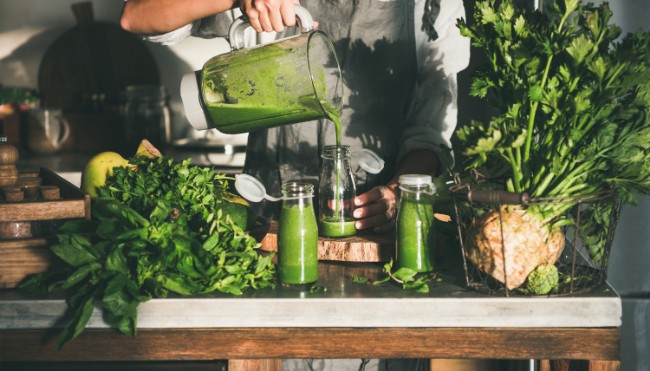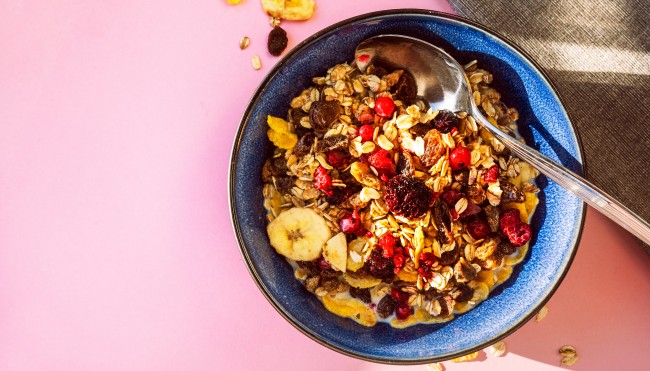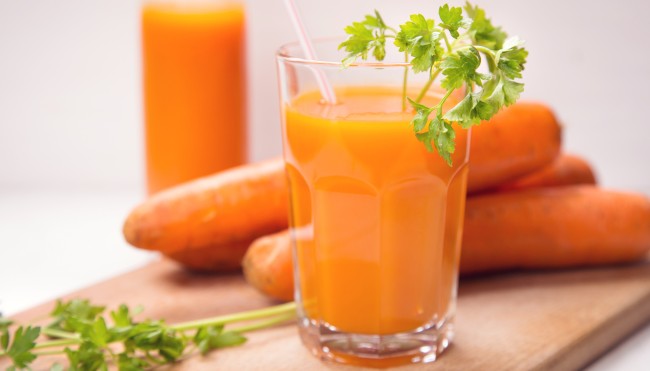Are green smoothies really healthy?

We all know the big trend of drinking a huge “green smoothie” or a “cold-pressed green juice” first thing in the morning: everyone from health experts, VIPs like Gwyneth Paltrow to IG influencers are drinking them! But are they really healthy?
Both the green beverages have been shown and suggested as the healthy hack of our time. Spinach, kale, green apples, lettuce, celery are the main characters and they are all healthy and essential...however “green” doesn't always mean “natural”, “healthy” and “good for your body”. In this article we´re gonna make clarity around the big hype behind the trend of drinking “ your daily greens”.
What is the differnce between smoothies and juices?
Which one to choose? Juices are different from smoothies for one specific reason: fiber content. They both have almost the same ingredients but different types of production: juices are made through a juicer/extractor that extract water, vitamins and minerals from the pulp, leaving out fibers. Smoothies are made with common kitchen blenders and they maintain the veggies and fruits pulp, so they have higher concentration of fibers. Why do fibers matter? Because of many reasons:
- help in slowing down the digestion
- help to stabilize blood sugar level
- is the nutrient to maintain alive and prosperous good bacteria in the gut
- has an important role in keeping ourselves full and satisfied for longer
- essential for regular bowel movements
- Research has shown the effectiveness of fiber in reducing the risk of coronary heart disease in both males and females
Western diet is too low in fiber while being high in calories, that it becomes an extremely important nutrient such as protein, fats and carbohydrates. So in comparison with juices, smoothies have definitely something more to look at. However fibers are a good plus, for some people they are not: if you don´t like a specific veggie for its taste and consistency, if you suffer when you eat lot of fiber at one time, or if you don't like the texture of greens pulp, than juices are your go to.
However we at CodeCheck are ”team smoothies” and this is why: both the drinks contain high levels of sugars! When the stomach doesn't have a solid food matrix to digest, like in juices, glucose and fructose (both sugars findable in veggies and fruits) are easily absorbed in the gut, arriving into the bloodstream, causing sugar spikes and a continue insulin production (which makes us always hungry!). Fibers from the pulp contained in smoothies make the difference, because they help in slowing down digestion and regulate sugars absorption.
It is very complicated to estimate how many and which nutrients are extracted during the preparation of juices and how many are actually contained in the final juice portion. A lot of micronutrients often remain in the pulp, which becomes a big waste of juicing: to prepare 1 litre of juice you have to use three times more the amount of vegetables and fruit! However if you have a varied, balanced diet that includes lots of whole foods and fibre, you can indulge sometimes in fresh juices, always remembering their high sugar amount per serving (sometimes almost like a coke can). For these reasons if you want to go further in “drinking your daily greens” we suggest you to prefer smoothies, especially if, like most of the people nowadays, you eat low fibre and a lot of processed foods. Let's try now to understand their pros and cons.
Are they better than real veggies and fruit?
First of all let's clarify that green smoothies cannot be a substitution of real, whole foods, even though they are pure blended veggies. Drinking a big green smoothie once a day does not allow you to indulge in processed and junk foods. Smoothies in fact can count as no more than one of the 5-a-day portions, diet recommendations in auge in the UK, even if 5 different vegetables and fruits are blended. Even more important is that nothing is better than the natural eating and digestive process. Chewing is different from drinking: when you chew, many different signals are sent to the body, stimulating both the brain and the stomach to start the digestion process. Already from the mouth our body absorbs nutrients and starts producing digestive enzymes, and this works especially for carbs and fibers. The more you chew, the easiest is gonna be the digestion. Chewing for longer helps people eat less, because it releases hormones that regulate appetite in the brain and gives a feeling of satiety, as confirmed by a study conducted by Chinese researchers and published in the American Journal of Clinical Nutrition. Drinking does not trigger all these mechanisms and that is why after drinking a smoothie hunger can quickly come over. Fibres and nutrients have entered our body, but it's like our stomach did not realize it.

Do they have scientific proved benefits?
The green smoothies trend arrived before there was any valid study! Science started to explore and study possible properties and benefits after they were already so popular and shown as miraculous for weight loss and general well-being. Many of their health benefits were simple assumptions based on the fact that fruit and vegetables are essential for our health. As already mentioned, one of the biggest problems with the modern diet (in both developed and undeveloped countries) is the lack of whole foods and fibre, that has been correlated to chronic disease, weight gain, infant obesity and malnutrition. Still as of now cardiovascular disease and cancers are the two leading causes of death in industrialized countries and it is estimated that one third of cancer can be prevented through dietary modification.
Hence the need to recommend to the population to increase the consumption of whole fruit and vegetables, which is not an easy thing. Especially for those generations who have grown up on junk food, convenience products, fast foods, that are addicted to salt, sugar and fats, eating vegetables can be very difficult because of taste, habits and gut intolerance. In fact when you start eating food high in fiber you can experience bloating, flatulence and bad digestion. But it's a totally normal process before the gut becomes used to fibers. To try to escape bad taste and digestion´s trouble, smoothies and juices have been suggested, even though there is still limited research on these nutritional therapy methods.
There are promising studies like this randomized controlled trial that shows how the habitual integration of green smoothies in the diet may offer health effects that could help in preventing and decreasing incidence of chronic diseases. Another study demonstrated that offering fruit-smoothies as part of a school breakfast program led to an increase in the number of adolescents consuming more than 1 serving of fruit and the total number of fruit servings consumed. On the contrary other studies show that the consumption of smoothies can increase the daily intake of calories and sugar while giving a health perception to the consumer: a cross-sectional study runned on Australian consumers finds out that smoothies are frequently consumed because of the perceived health benefits. However they are often made using a combination of energy providing ingredients and not just pure veggies and so regular consumption of energy dense smoothies may predispose individuals to excess energy. One study also shows how liquids may be less satiating than nutritionally-comparable solid and semi-solid foods, possibly due increased rate of ingestion, reduced mastication, and increased rate of gastric emptying. A reduction in satiation has also been attributed to the perception that liquids are primarily consumed to satisfy thirst and solid foods are largely ingested to satisfy hunger, inducing the effect of not being satisfied after a smoothie even though it can bell full of calories.
As we can see the topic is still very controversial and we at CodeCheck always want to explain the big picture. Whether smoothies are bad or good for our health is still something that research needs to deepen and study, especially because of the increasing industry and use of them as meal replacement.
10 Tips to consume green smoothies properly and add them in our diet
Though published scientific data on rates of smoothie consumption are limited, the availability and accessibility of these beverages certainly appears to have increased, not only on the market but also at home. Commercial reports suggest that the “smoothie industry” has experienced considerable financial growth in many countries like Australia, New Zealand, the UK and USA. So...what should we do? Drink it or not? Let's be honest, smoothies are fresh, delicious (especially with fruits and nuts), and they give us the perception that we are doing something good to our body. And during this time, having a fresh treat, different from chocolate and salty snacks can be a good fella for our mental health as well. As we always suggest at CodeCheck, moderation is the key! You can keep drinking your favorite smoothies adopting some simple and healthy strategies. Here our 10 tips to consume smoothies mindfully while not overindulging on sugars and calories:
- Never use smoothies as substitutes of whole fresh fruits and veggies.
- Try a different recipe every time remembering to use fresh green veggies like broccoli and celery and leafy greens such as spinach, rucola, kale as a base, to also enrich it with natural occurring protein
- Try to drink it slowly keeping it in the mouth for some second in order to activate salivation and digestion
- Add 1-2 fruits to enhance vitamin C content and to give it a better taste
- Fibers are powerful prebiotics: add some plain yogurt (even plant based) to add natural probiotics
- Pare your smoothie with solid nutrients-rich foods to have a complete and balanced meal: nuts, whole grains, oats, shredded coconut are examples.
- The more colors you use the better! Colors mean many different nutrients such as carotenoids and antioxidants at one time
- Try to add ginger, to support liver and gastrointestinal functions
- From time to time add cocoa or nuts butter to add more creaminess and to satisfy sweet cravings
- Seeds are the perfect solution to make a smoothie like a consistent pudding! Add 1-2 tablespoon of chia seeds or grounded flax seeds to boost texture and to add omega-3 essential fatty acids.





